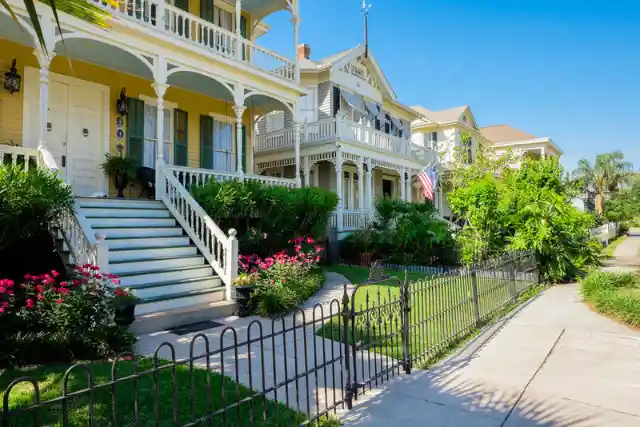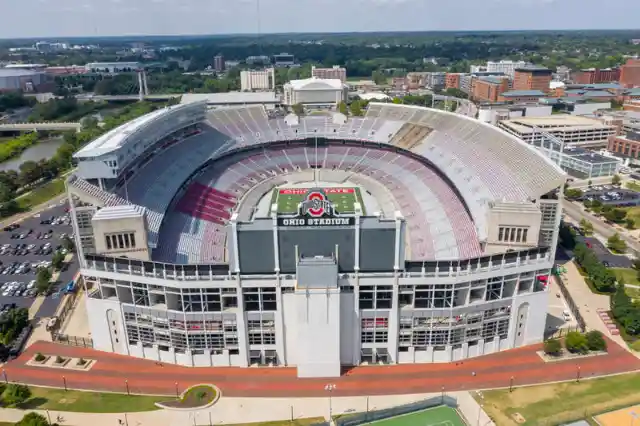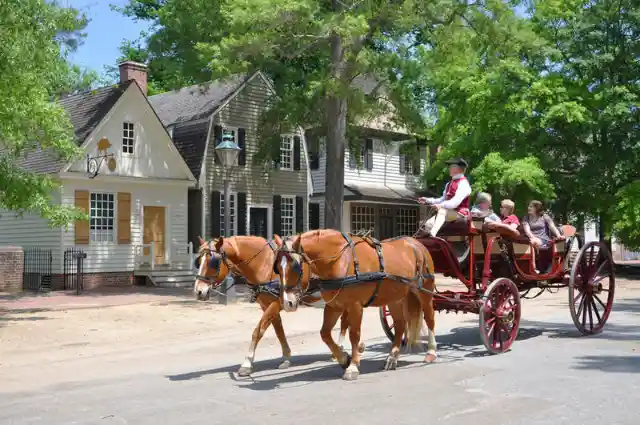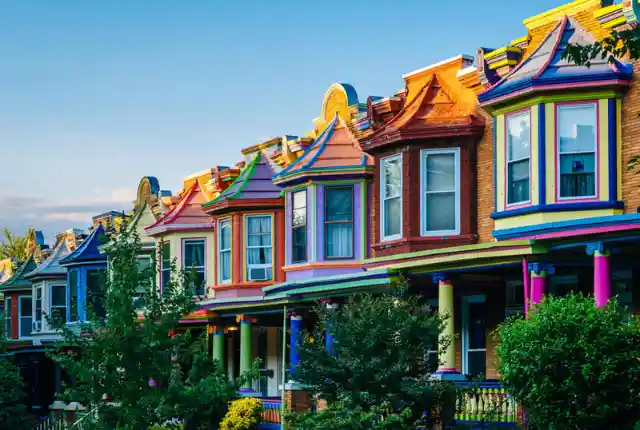Retirement is the big (and well-deserved) reward at the end of a long working life. To ensure that retirement goes smoothly, it’s important to consider a few factors. Safety, accessibility, community, and infrastructure are high up on the list. No one wants to live in an unsafe place in the middle of nowhere without community or infrastructure.


However, those concerns also need to be balanced with concerns about affordability. Many retirees depend on social security or fixed incomes, so it’s important to look into the average cost of living and state taxes. We’ve done that below, weighing the pros and cons of each of the 50 states. Let’s take a look.
Arizona
Cost of living: 3% above the U.S. average
Population: 6.7 million
Share of population 65+: 15.9%


Arizona is world-famous for the Grand Canyon. That towering symbol of natural beauty draws millions of people each year. Alongside the canyon, there are plenty of other gorgeous landscapes for desert lovers. The sunrises and sunsets are the stuff of legends. Retirees have been flocking here for a while, due in large part to the (relatively) low cost of living in cities like Phoenix. You don’t have to worry about taxes on groceries, but there is sales tax. Taken altogether, it’s a good balance.
New Mexico
Cost of living: 5% below U.S. average
Population: 2.1 million
Share of population 65+: 15.3%


The cost of living in New Mexico is lower than Arizona and the national average. That being said, if you’re looking to retire here, then we have some unfortunate news for you: pensions and social security are taxed. However, if you have a low income, then you might be exempt. If you can make the financials work out, then New Mexico is a great place to retire – there are plenty of artists around, plenty of landscapes to admire, and the state ranks high in safety.
Montana
Cost of living: 3% above the U.S. average
Population: 1.0 million
Share of population 65+: 16.7%


If you’re a big nature lover, then Montana is definitely for you. The so-called “Treasure State” (a throwback to its days of gold and silver mines) includes both Glacier National Park and a bit of Yellowstone. That being said, you can’t live off beautiful views of mountains. You need a place to live, some infrastructure, and details about taxes. The unfortunate news about Montana is that the financials can be pricey because social security and other forms of income are taxed.
Texas
Cost of living: 10% below U.S. average
Population: 27.0 million
Share of population 65+: 11.5%


The Lone Star State has spiked in popularity over the past few years. Everyone from 20-somethings to middle-agers to retirees have found Texas to be an attractive place to live. Some choose the big cities of Austin, Houston, and Dallas. Plenty of other people opt for small-town living in a quiet place with a stable economy. The pandemic year of 2020 saw a mass migration of people relocating from California. Not only is there plenty of space in Texas, but residents don’t have to worry about taxes on social security, pensions, or retirement income.
Vermont
Cost of living: 12% above the U.S. average
Population: 626,249
Share of population 65+: 17.0%


Vermont is a small New England state well-known as the home of Ben and Jerry's. Alongside delicious ice cream (we recommend the classic chocolate chip cookie dough), the Green Mountain State has a vibrant arts scene and, as you might have guessed, gorgeous mountains. Every pro has a con though, and for Vermont, that’s the high cost of living. The state indeed has excellent medical care but retirees should also be aware that social security and retirement income are taxed.
Utah
Cost of living: 4% above the U.S. average
Population: 2.9 million
Share of population 65+: 10.0%


When most people think of Utah, they think of the Great Salt Lake that gave Salt Lake City its name. Although that natural feature is remarkable, the state also offers plenty of other outdoor spots to take in. This includes national parks (including Arches and Zion), state parks, national forests, and national monuments. Alongside the stunning natural beauty, the state also has fantastic healthcare and general infrastructure. One of the downsides, however, is that retirees are taxed on their social security.
Maine
Cost of living: 2% below U.S. average
Population: 1.3 million
Share of population 65+: 18.2%


Maine is a massive state in the northeast corner of New England. Nearly one out of every five people in the state is a retiree. Alongside the gorgeous landscapes and quiet life, a big reason for that is the relatively affordable healthcare (below the national average). As far as social security goes, retirees are exempt from paying taxes. However, taxes apply to other sources of retirement income. If you have a large estate, then you’ll have to pay estate tax as well.
Ohio
Cost of living: 12% below U.S. average
Population: 11.6 million
Share of population 65+: 15.5%


The state of Ohio is well-known for hosting the Rock and Roll Hall of Fame. Alongside rock music, the state loves sports. There are plenty of medium-sized cities, quiet suburbs, and small little towns to choose from. In terms of retirement, Ohio offers a low cost of living compared to the national average. Alongside that, the state doesn’t tax social security and offers some property tax discounts for those on a low or fixed income. For those reasons and more, the Buckeye State is a promising place to retire.
Florida
Cost of living: 1% above U.S. average
Population: 19.9 million
Share of population 65+: 19.1%


When people think about retirement, they think about Florida. The Sunshine State is full of retirees spending their days lounging on the beach or hanging by the pool. Nearly 3.8 million people choose to retire here. Besides the beaches and summer weather, one of the biggest reasons that people do that is the tax laws. The big three of inheritance tax, estate tax, and state income tax don’t apply here. Also, your social security and retirement income won’t be taxed.
Tennessee
Cost of living: 12% below the U.S. average
Population: 6.5 million
Share of population 65+: 15.0%


The state of Tennessee is high up on the list for retirees with a fixed income. There are three main reasons for that: the cost of living is well below the national average, the cost of healthcare is below the national average, and the state has no income tax. Alongside the financial incentives, the state itself also has plenty of nature and culture. Mountains are only a short drive away and the cities of Nashville and Memphis are pretty much synonymous with great music.
Minnesota
Cost of living: 4% above the U.S. average
Population: 5.5 million
Share of population 65+: 14.3%


Known far and wide as the Land of 10,000 Lakes, Minnesota has a lot of natural beauty for retirees to explore. It's not hard to purchase a home on a private lake, with such abundance. Healthcare has a great reputation here, as well. But how are the taxes, in between canoe outings? Apparently, Minnesota taxes not only Social Security benefits but targets retirement income. This includes government, military, and private pensions. Yikes!
Oregon
Cost of living: 18% above U.S. average
Population: 4.0 million
Share of population 65+: 15.9%


Another option in the Pacific Northwest is Oregon, home to the famously weird city of Portland. There's always a bookshop or a farmer's market to explore here, banishing boredom. Its quirky residents love how different things are, and retiring in the state has a few perks. Social security benefits are not taxed. Healthcare costs are slightly lower than the national average. And there's no sales tax, at all! Still, the cost of living is higher than average. Newcomers must decide: Is that balance good enough?
South Carolina
Cost of living: 7% below the U.S. average
Population: 4.8 million
Share of population 65+: 15.8%


Mild weather and southern charm combine in South Carolina, an increasingly popular retirement destination for Americans. What are the real reasons people are choosing to relocate to the Palmetto State? With no social security, inheritance, or estate taxes, peven former skeptics see the benefits quickly. Living costs are below average to begin with, and property taxes are low for homeowners. Admirers just have one question: How does the state achieve it all?
Alaska
Cost of living: 32% above average
Population: 736,855
Share of population 65+: 9.4%


It's far away, sure. But the state known as the Last Frontier is a gorgeous place to spend the golden years. Not many people choose it, as of now. Under 70,000 people are actually age 65 and older! But those who do know they are exempt from state income taxes. Plus, they get an extra exciting check: Alaskans receive dividends from the oil business in the state, around a thousand bucks a year. Maybe that helps with the high cost of living, more than 9% above the national average!
Georgia
Cost of living: 7% below the U.S. average
Population: 10.1 million
Share of population 65+: 12.3%


Warm weather, peach trees, and low living costs are all great reasons to retire in Georgia. According to recent assessments, healthcare costs are below average for seniors. Plus, the tax situation is very appealing: No Social Security taxes, and a deduction of up to $65,000 per person for retirement income. Sales tax is pretty moderate, compare to other states. And finally, perhaps most appealing to some, there are no inheritance or estate taxes!
New Jersey
Cost of living: 27% above the U.S. average
Population: 8.9 million
Share of population 65+: 14.7%


The Garden State is known as a bit of a suburb of NYC, truthfully. During the working years, many commute each and every day to the big city nearby, and relax back in the suburbs at night. But is it a good place to retire, permanently? With the third-highest healthcare costs in the nation and the number one ranking for property taxes, maybe not. The cost of living for everyday items is already above average!
New York
Cost of living: 22% above the U.S. average
Population: 19.7 million
Share of population 65+: 14.7%


The city that never sleeps is located here, and might seem like the next adventure. But New York is not the cheapest place to retire, according to the numbers. Surprise, surprise! The stats are a bit misleading because the big metropolis of NYC pulls up the percentage considerably. Costs in the city are a whopping 138.6% above the national average and that affects the statewide number. Upstate is gorgeous, though. There are a few areas with costs below the national average!
Pennsylvania
Cost of living: 3% below U.S. average
Population: 12.8 million
Share of population 65+: 16.7%


Home to contrast, this state boasts both Philadelphia and the Amish. But what about retiress? Health care costs in Pennsylvania are slightly below the national average. Social security is not taxed, and the cost of living is below the national average. All sounds good, so far. But chatter about the fiscal health of the state makes these promises uncertain, for the long term. Pennsylvania ranks at the bottom nationally, for budget balance. How will gaps be covered, if not through tax increases? Only time will tell, indeed.
Hawaii
Cost of living: 87% above the U.S. average
Population: 1.4 million
Share of population 65+: 16.1%


Retiring on one of the Hawaiian islands is a secret dream of many Americans. Paradise doesn't sound half bad, by any means! But when they hear about the cost of living, most reconsider. It's not cheap, to say the least: With the most expensive cost of living on the list, it isn't a prime destination right now beyond vacation. The one redeeming quality is healthcare costs, from a financial standpoint. At 11.4% below average, it might make up for a few other bills. But for most, the decision will be Aloha, Hawaii!
Nebraska
Cost of living: 12% below U.S. average
Population: 1.9 million
Share of population 65+: 14.4%


Nicknamed the Cornhusker State, Nebraska is a wild and wonderful place to retire. In many ways, it's a place to find peace. Low crime, beautiful prairie landscapes, and a low cost of living mean saying goodbye to a lot of city troubles. Tax-wise, there could be a few hiccups, though. Social security is exempt for those with less than $43,000 of retirement income. Relieving, sure. But most other retirement income can be taxed at normal rates!
Illinois
Cost of living: 4% below U.S. average
Population: 12.9 million
Share of population 65+: 13.9%


Home the world-renowned city of Chicago, Illinois residents never have to be bored. With sports stadiums, opera, theater, and museums, and a lot of Lake Michigan shoreline, there are endless reasons to retire in close proximity to this midwest gem. The suburbs are sprawling, and beyond that, there is small-town life throughout the state. The cost of living is below the national average outside the big city, too. Currently, retirees enjoy a lot of tax breaks. But because of state budget problems, year after year, some analysts are unsure if that can continue. Wait and see, maybe!
Mississippi
Cost of living: 15% below U.S. average
Population: 3.0 million
Share of population 65+: 14.3%


And what about Mississippi living? The South seems to have a lot of hidden gems, these days. Low costs are just a way of life for residents of the Magnolia State. Retirees are happy with the generous tax breaks, too. Social Security, as well as distributions from IRAs and 401(k)s are not taxed at all. Property taxes are minimal, at the same time. While healthcare is not currently the best in this state, the appealing financial breaks are hard to ignore!
West Virginia
Cost of living: 17% below the U.S. average
Population: 1.8 million
Share of population 65+: 17.8%


Time for the winner! West Virginia is often referred to as Mountain State, for good reason. It's completely within the Appalachian Mountain region —the only state to boast this title, in fact. With abundant natural beauty around its small towns, friendly neighbors make this destination a great option for newcomers. Around 1.8 million people currently enjoy West Virginia year-round. Advertising the lowest cost of living in the country, it deserves attention from everyone!
Alabama
Cost of living: 13% below average
Population: 4.8 million
Share of population 65+: 15.3%


Sweet home Alabama might be the next home sweet home for retirees looking for a better lifestyle. Right in the Heart of Dixie, warm weather, plenty of golf, and sunny beaches are all available at low cost. Healthcare is cheaper than the national average, and Social Security benefits are exempt from an already low tax system. Public and private pension income is also free from taxation. An enthusiastic local football culture is just the cherry on top!
Rhode Island
Cost of living: 22% above the U.S. average
Population: 1.1 million
Share of population 65+: 15.8%


Tiny Rhode Island is a place that usually flies under the radar. Not many people actually live here, and it looks like there might be a good reason why. Financially, things are not advantageous for retirees! Living expenses are above average, to begin with, and some income is taxed. But there is one bright spot: Social security is not taxed for those with additional income below $80,000. There are pros and cons, for sure!
California
Cost of living: 52% above the U.S. average
Population: 38.7 million
Share of population 65+: 12.9%


Ah, the Golden State. With beaches galore and top cultural attractions, California has long been a choice for relocators looking for fun in the sun. But the reality is, the cost of living has been rising for everyone in the state for decades. That includes prospective retirees! Currently, stats indicate that 1 in 10 retired residents are living in poverty. Beyond social security checks, retirement income here is taxed. Is it worth the move? Maybe not, for now!
Wisconsin
Cost of living: 4% below U.S. average
Population: 5.8 million
Share of population 65+: 15.2%


The dairy state might be an attractive destination for cheese lovers, at the very least. But Wisconsin is also home to Milwaukee, a moderately big metro area with a lot of attractions. Sports fans will enjoy the baseball opportunities in the city and the football opportunities outside of it, way out in Green Bay. Financially, the cost of living is below the national average and Social Security is exempt from state tax. Unfortunately, other retirement income may not be — and healthcare costs are above average!
Virginia
Cost of living: 7% above U.S. average
Population: 8.3 million
Share of population 65+: 13.8%


Virginia offers interesting perks for history buffs out there. The site of famous battles and events in the nation's history, there are charming places galore for retirees to explore. It's also one of the borders of Washington DC itself, a source of more entertainment. But are there reasonable financial perks? Social Security benefits are not taxed here, and up to $12,000 can be deducted in income tax per resident. Something to weigh against cost of living, perhaps!
Washington
Cost of living: 21% above the U.S. average
Population: 7.1 million
Share of population 65+: 14.0%


Home to the famous city of Seattle, Washington has a lot going on. For those looking to escape city life, the Evergreen State has not one, but two mountain ranges and more than 3,000 miles of coastline. And even those who decide that urban living is the best for them, there is always a hike, swim, or boat ride in nature nearby. Known for the physically active senior citizens, many might see Washington as a great relocation. But not so fast: Cost of living is well above average, so savings are key!
Missouri
Cost of living: 10% below U.S. average
Population: 6.1 million
Share of population 65+: 15.4%


Retirement advantages abound in the Show-Me State, year after year. Missouri has low living costs, year round. Retirees should be aware that Social Security and public pensions are taxed, in a limited way. Private pensions are taxed like regular income. But that's for couples with incomes over $100,000! Below that, there are some exemptions. In general, Missouri is regarded as moderately tax-friendly for seniors. On a case-by-case basis, it might be the right choice!
Kansas
Cost of living: 14% below average
Population: 2.9 million
Share of population 65+: 14.3%


Maybe people haven't heard much about Kansas since Dorothy skipped down the yellow brick road. But there is a modern lifestyle out there, and it's an impressive 14% below the national average in expenses. That is still true, even with a relatively high sales tax. When retired, a few other issues tend to come up when considering a move to the sunflower state. For those with gross income below $75,000, Social Security benefits are exempt from taxes. There is no estate or inheritance tax either. As Kansas residents know well, there's no place like home!
New Hampshire
Cost of living: 18% above U.S. average
Population: 1.3 million
Share of population 65+: 15.9%


New Hampshire doesn't tax Social Security or retirement income. It's spoken of highly for healthcare, for seniors. And it has no sales tax, shockingly! There are clearly many reasons to retire in the Granite State. But for those who are done with their working years, it is worth noting that the cost of living is higher in general, compared to the rest of the nation. For some, it might still be a big upgrade!
Connecticut
Cost of living: 24% above the U.S. average
Population: 3.6 million
Share of population 65+: 15.5%


While it has lovely ports, classic new England town, and autumn leaves galore, the nuts and bolts of Connecticut are not idyllic, finally. Real estate taxes are some of the very highest in the country, retirement income is taxed. That sometimes includes social security, incredibly! While most residents have incomes well above the national average to offset such costs, it might not be a target for out of staters looking for relocation. The truth hurts, sometimes!
Michigan
Cost of living: 12% below U.S. average
Population: 9.9 million
Share of population 65+: 15.4%


The midwest has a jewel called Michigan, and more retirees have been taking notice. Suburbs, cities, and remote lakehouses are all options here. Plus, the Great Lakes provide natural beauty and extensive freshwater shoreline. It has a low cost of living, a few options to minimize taxes in the golden years. Social security can be deducted from tax bills, or residents can substitute tax deductions in other areas. An accountant can explain the biggest benefits, for everyone!
Iowa
Cost of living: 12% below U.S. average
Population: 3.1 million
Share of population 65+: 15.8%


Corn, horses, and friendly folks are the backbone of Iowan life. And residents wouldn't have it any other way! Low living costs make the Hawkeye State very appealing for older Americans. That even includes health care costs, which are 5.6% below average, a welcome rele9f for many. But the taxes less than ideal, beyond social society's exemption from the code. Some retirement income can be taxed at nearly nine percent! Depending on the household, Iowa is still worth a look.
South Dakota
Cost of living: 4% below the U.S. average
Population: 851,058
Share of population 65+: 15.2%


Most people can easily say that South Dakota has Mount Rushmore and a whole lot of buffalo. For tourists, it's tons of fun. But what are the lives really like for older residents? As it turns out, pretty good. The cost of living is below average, and it has no income tax. None, at all! The sales tax is also low, and there are inheritance or estate taxes. Sounds like a big difference, from the states many currently call home!
Maryland
Cost of living: 17% above U.S. average
Population: 6.0 million
Share of population 65+: 13.8%


With close proximity to the nation's capital and its cultural attractions, Maryland might be an interesting place to reside for older Americans. The DC Smithsonian is just a short ride away, and its capital of Baltimore has a lot to offer with its own entertainment. Sprawling suburbs offer a refuge, during the week. But financially, it's a high tax place. Social security is exempt, but there is a catch: Maryland has both an estate and an inheritance tax!
Oklahoma
Cost of living: 16% below U.S. average
Population: 3.9 million
Share of population 65+: 14.5%


Oklahoma is not currently ranked highly in healthcare for seniors. But the other financial draws mean that it still might be worth a look. Social Security benefits are tax-free, all available to spend on the low cost of living. Up to $10,000 of retirement income per person is exempt too. Not a bad deal, for many Americas looking to relocate. A new home soon is available for seniors in The Sooner State, if they dare!
Wyoming
Cost of living: Same as U.S. average
Population: 583,029
Share of population 65+: 13.8%


Remote Wyoming doesn't get a lot of press, does it? Admittedly, it is pretty quiet. But that doesn't mean there isn't a reason to talk about it! Those who love world-class mother nature will enjoy owning property there, away from the world. There is no state income tax, since many government expenses are covered by revenues from mineral and oil rights. There is low sales, on top of the literally average cost of living. Cowboys at heart, come on down!
Colorado
Cost of living: 17% above U.S. average
Population: 5.4 million
Share of population 65+: 12.7%


Rocky mountain high, this state is worth singing about. John Denver knew this was a special place to reside! For a variety of reasons, people are willing to deal with the elevated cost of living in retirement. Senior healthcare is better than a lot of states, and there are a lot of ways to be active around the mountains and rivers. Plus, the Colorado Old Age Pension program offers extra peace of mind. Those over 60 with low incomes are eligible for the benefit. Nice, Colorado!
Kentucky
Cost of living: 14% below the U.S. average
Population: 4.4 million
Share of population 65+: 14.8%


Kentucky does not currently have the best healthcare rating for seniors. But the other perks of living in the Bluegrass State might still be appealing,m on balance. For example, residents enjoy tax exemption for Social Security benefits and up to $41,110 of retirement income. The cost of living is low, day to day. And the horse racing culture is unique, with nothing quite like it in the nation! Big hats and cocktails, anyone?
Idaho
Cost of living: 5% below the U.S. average
Population: 1.6 million
Share of population 65+: 14.3%


Idaho has enough potatoes, for retirement cooking. But what else is going on there? As it turns out, some tax breaks worth looking into for the next chapter ahead. With a cost of living already below average, residents laud their lack of inheritance and estate taxes. Social security is not targeted for taxation, either. Sounds good, say most looking into a move. But there is a catch, or two: Statewide sales tax and income tax!
Arkansas
Cost of living: 17% below average
Population: 3.0 million
Share of population 65+: 15.7%


Arkansas is often overlooked, but not today. Bordering the Mississippi River, hikers have always known the Wonder State is for its wilderness, mountains, caves, and hot springs. But what about full-time residents, in the older years? Arkansas is seen as a tax-friendly state for retirees, and for good reason. At age 65, residents receive a property tax freeze and reductions from other local obligations. Social Security benefits and some retirement income — up to $6,000 — is tax-exempt, too!
North Dakota
Cost of living: 1% above U.S. average
Population: 736,162
Share of population 65+: 14.2%


North Dakota is not too crowded, by any means. With a population of just over 730,000, there is space to breathe and relax in a refuge from city life for retirees. It's beautiful, and the people who choose life there are regarded as pretty friendly folks. Social security and other income are slightly taxed, between 1-3 percent. And the cost of living isn't so bad, overall. At just 1% above the national average, people don't complain!
Indiana
Cost of living: 15% below the U.S. average
Population: 6.6 million
Share of population 65+: 14.3%


With friendly suburbs and entertainment in the capitol, Indiana is currently home to 6.6 million folks. The state is a great option for those looking for low-cost life in the midwest. Incomes are lower overall, so it may not be easy-breezy for lifelong Hoosiers. But those relocating with reasonable savings have an advantage getting the most bang for their buck. Something to keep in mind for seniors: Social security income is exempt, but most other kinds are not!
Louisiana
Cost of living: 10% below U.S. average
Population: 4.6 million
Share of population 65+: 13.6%


Easy access to the Gulf Coast and New Orleans is one thing Louisiana offers all residents. If vibrant southern culture is part of the criteria, this state can't be beaten. When it comes time to retire, finances are also a factor, of course. Incomes are lower than average in Louisiana, but so is the cost of living. For retirees relocating with a lot of savings, it could be a good deal! Gumbo and jazz, anyone?
North Carolina
Cost of living: 5% below average
Population: 9.9 million
Share of population 65+: 14.7%


Basketball, BBQ, and waterfalls are just the beginning. With its mild weather and gorgeous coastline of the Atlantic ocean, North Carolina has a lot of appeal these days for new residents. For retirees, average sales taxes and friendly cities are attractive reasons to stay. Social security isn't taxed, either. It's worth noting that seniors who have a lot of income outside of government benefits will have a tax bill. But over age 65 at lower incomes, property taxes are eliminated!
Delaware
Cost of living: 11% above U.S. average
Population: 934,695
Share of population 65+: 16.5%


Delaware is basically famous for being the first state in the union. Early to join, and enjoy the credit to this day! But it's a small place, and not everyone knows what's going there, tax-wise. The few who live there know that Social Security benefits are not taxed at all, and $12,500 of investment or pension income is potentially exempt as well. Healthcare costs are slightly below the national average, but there is one catch. Overall, daily living costs run 11% above the U.S. average!
Massachusetts
Cost of living: 38% above the U.S. average
Population: 6.7 million
Share of population 65+: 15.1%


Time for an inventory on Massachusetts. East coasters know that Boston has a lot to offer culturally and intellectually. The home of Harvard, MIT, and the Red Sox, residents have a lot to brag about. And outside of the metro area, there's a lot of natural beauty in the state! But the cold, hard facts don't lie: MA has the second-highest healthcare costs in the nation, and it taxes retirement income. Social security checks are safe, but this state may not be the safest bet for savings!
Nevada
Cost of living: 4% above U.S. average
Population: 2.8 million
Share of population 65+: 14.1%


It's time to evaluate Nevada! Those who don't want to gamble with their savings might want to avoid this state. Sure, it is home to a world-class attraction. People travel from all over the world just to experience the lights and action of Las Vegas. Residents can enjoy novelty year-round if they so choose. But living there full time has its drawbacks. While no state income tax is very appealing, there is a catch: Costs are higher than average!